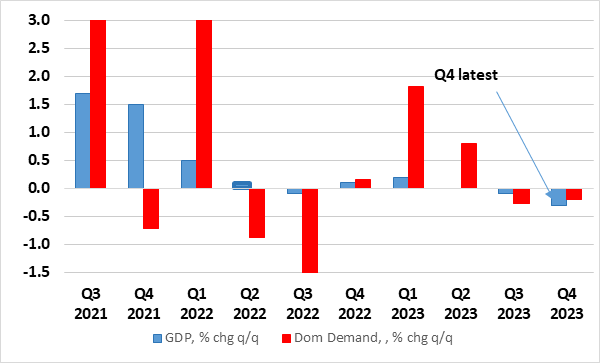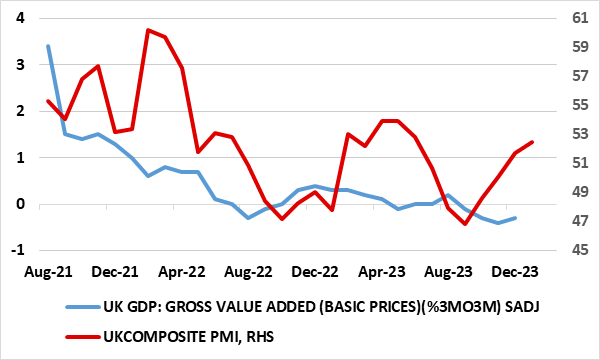UK GDP Review: Recession Confirmed

Coming in lower than expected after taking account of downward revisions, and probably hit by industrial action, GDP shrank by 0.1% m/m in December data, a result that reflected the plunge in retail sales and abnormal weather that meant a Q4 drop in GDP and consumer sending (Figure 1). Admittedly some upside risks were posed by some survey data, but where the likes of PMI numbers have been very poor guides to GDP swings (Figure 2). As for those swings, the December result and revisions meant a 0.3% q/q Q4 drop, both below the BoE’s flat projection and meaning that, after the Q3 decline, the economy was in formal recession. The underlying trend is one of stagnation given that GDP rose a bare 0.1% on average in 2023, albeit where per capita GDP fell for the sixth quarter in seven. We see stagnation continuing this year, with even a risks of a modest GDP drop on average for 2024.
Figure 1: A Second Successive Fall in Both GDP and Consumer Spending

Source: ONS, CE
Downside Risks Still Clear?
In terms of recent momentum, monthly GDP is estimated to have fallen by 0.1% in December 2023, following growth of 0.2% in November 2023 (revised down from a 0.3% growth) and a fall of 0.5% in October 2023 (revised down from a fall of 0.3%). GDP was flat in y/y terms and was down almost 1% from the aberrant July figure, all indicative of a flat underlying trend at best. As for the most recent numbers, the main driver to the 0.1% m/m fall in services in December 2023 was wholesale and retail trade; repair of motor vehicles and motorcycles, which saw a 1.9% fall on the month. Human health and social work activities fell by 0.9% in December 2023 following growth of 0.2% in November 2023, this a result of three days of industrial action by junior doctors and hospital dental trainees.
As for the larger than expected Q4 GDP drop, there was a fall in the volume of net trade, household spending and government consumption in Quarter 4 (Oct to Dec) 2023, partially offset by an increase in gross capital formation. It is unclear to what degree that the latter was inventory driven.
Figure 2: PMI Composite Survey - A Poor Guide to GDP Swings?

Source: Markit, ONS
As for the economic outlook, our relatively gloomy scenario may seem to be in conflict with survey data that have seemingly shown some degree of resilience in the last few quarters. Indeed, PMI data have perked up late but these numbers have been very poor indicators of actual GDP swings in recent years (Figure 2), especially the composite measure which excludes construction, government and retailing, perhaps the three sectors most affected by policy both monetary and fiscal. Even so, there are supportive factors: not least the marked drop in wholesale energy prices which will filter through in another bout next quarter and where the fiscal situation is going to be little more supportive than previously envisaged. But businesses are losing much of the energy support cushion through 2024. However, the main concern is clearly the impact of the sizeable tightening in monetary policy that is already causing tighter financial conditions that will increasingly bite the economy through the credit channel, this very much highlighted by unprecedented declines occurring in both the level of bank credit and bank deposits. This fragile outlook is very much led by the consumer, the most exposed to likely outright damage from the housing market. In perspective, this will involve consumer spending and slipping a little in 2024, after just 0.3% growth last year. As for last year, the economy grew just 0.1% and we see no growth at all this year, with a risks of modest contraction.
Recession Signaled?
The Q4 GDP drop is an outcome weaker than the flat picture painted by the BoE. Over and beyond the monetary policy repercussions, (actually more driven by inflation dynamics), the question is will such a result add to the government’s already shaky and divided position.